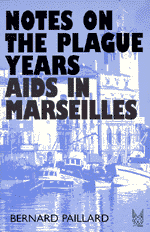

![]()
![]()

Having said all this, there is much in this book which showcases the advantages of the research methodology chosen, and of the relaxed narrative voice of the author. Though sometimes over long, Paillard writes clearly and evocatively of his experiences in Marseilles and his wide ranging exploration over four years through the curiously self-contained social settings he find himself in yields some fascinating and often disturbing insights. There are possibilities of a dozen research projects raised by this exploration, reported over twenty chapters, each of which deals with the impact of HIV/AIDS in the conurbation of Marseilles. While there is some overlap in these chapters as the book progresses, each provides a 'snapshot' of the response to the emergence of an incurable communicable disease. The most rewarding elements of this book are the insights gained from the response of the medical, para-medical and alternative medical spheres. In particular Chapters 3-7 map out the intricacies of the interplay between professional knowledge and superstition; between the urgency of the need to respond to HIV/AIDS and professional hierarchies of power which truncated the effectiveness and even scope of the strategies undertaken. The irrational fears associated with blood and the secreting body are nicely illustrated alongside the almost contradictory growth of alternative medicine which sees the body as a temple destroyed by civilisation.
The curious feature, though, of the book overall is the relative lack of discussion about sex and sexuality. Even in the world of commercial sex and the gay communities, the connection between HIV/AIDS and sex is one which appears to require careful negotiation by the researcher. It is in these two worlds visited by the author that the methodological approach illustrates its greatest weakness. For both in relation to gay men and female sex workers, Paillard readily, and apparently without any sense of irony or self-reflection, admits to his lack of information about or links with members of these socially marginalised groups. His failure, for example, to access the world of the women sex workers 'undercover', either as a client or as a public health outworker, offered a clear opportunity for such self-reflection. Deploying either 'identity', the response raises some crucial questions about the role of the researcher in participant observation which were left undiscussed.
Paillard rightly acknowledges in his introduction that 'readers accustomed to academic reports will find the text disturbing' (xix) a disclaimer which raises the question of who would constitute the readers of this text. Despite its specific case study focus and monographic status, and hidden in the sometimes overlong passages, there are points of relevance which go beyond Marseilles or even France. There is a universality about the fragmentation of the organisation between related social settings and organs of administration which would prepare health professionals or researchers in the field for the sometimes hidden complexities of social organisation. The participant observation approach illuminates also aspects of lived experiences which are equally 'untidy', both at a community and individual level. As an account of a prolonged and wide-ranging research undertaking Notes on the Plague Years would serve as a useful example of the best and worst of participant observation for research students and teachers alike. Despite the shortcomings already discussed, Paillard's text reveals the minutae of a cultural setting in the context of HIV/AIDS which complicates the all too often over-simplified equation between knowledge and practice at the grassroots level.
Gail Hawkes
Manchester Metropolitan University